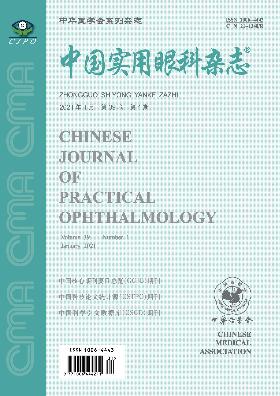荧光素染色检测激光光凝对真菌性角膜溃疡菌丝结构的影响
引用次数: 0
摘要
目的用荧光素染色法观察激光光凝对真菌性角膜溃疡菌丝结构的影响。方法对2016年1月至2016年8月在我院共聚焦激光角膜显微镜下诊断为真菌性角膜炎的患者28例(28眼)进行前瞻性随访。其中男性19眼,女性9眼,年龄24 ~ 63岁,平均(44.00±0.00)岁。平均发病时间3 ~ 18天,平均(9.00±0.00)天。9例(9眼)出现低视现象。除局部抗真菌氟康唑滴眼液和纳他霉素滴眼液外,所有患者均在表面麻醉下进行角膜荧光素染色和激光光凝。同时,采用体内共聚焦激光扫描显微镜检测激光手术后真菌菌丝的定位位置、范围及结构变化。结果荧光素染色法检测激光光凝对真菌性角膜溃疡菌丝结构的影响。荧光素染色检测激光光凝对真菌性角膜溃疡菌丝结构的影响。28例患者(28只眼)经激光光凝荧光染色检测,真菌性角膜溃疡均得到控制。9例患者垂体后叶均逐渐减少。激光光凝后,用激光共聚焦角膜显微镜观察溃疡内真菌菌丝结构的断裂和融化。随访3 ~ 6个月无复发。结论荧光素染色激光光凝检测导致真菌性角膜炎菌丝结构破坏。激光角膜共聚焦显微镜有助于检测激光手术后真菌菌丝的定位、范围和结构变化。因此,它是治疗真菌性角膜炎的一种安全、有效、精确的方法。关键词:真菌;角膜溃疡;共聚焦激光角膜显微术;激光光凝术本文章由计算机程序翻译,如有差异,请以英文原文为准。
The effect of laser photocoagulation on the hyphal structure of fungal corneal ulcer detected by using fluorescein staining
Objective
To observe the effect of laser photocoagulation on the hyphal structure of fungal corneal ulcer by using fluorescein staining.
Methods
A prospective research of 28 patients (28 eyes) diagnosed as Fungal Keratitis by using confocal laser corneal microscopy were followed up, who recruited from January 2016 to August 2016 in our hospital. Among them 19 males (19 eyes) and 9 females (9 eyes) with age ranging from 24 to 63, averages (44.00±0.00) years old. The average onset time was from 3 to 18 days, averaged (9.00±0.00) days. And hypopyon were observed in 9 cases (9 eyes). Besides topical anti-fungal Fluconazole Eye Drops and Natamycin Eye Drops, all patients also received fluorescein staining and laser photocoagulation under topical anesthesia for their cornea. Meanwhile, in vivo confocal laser-scanning microscopy were used to detect the positioning location, scope and structure changes after laser surgery of the fungal hyphae.
Results
Laser photocoagulation on the hyphal structure of fungal corneal ulcer detected by using fluorescein staining. Laser photocoagulation on the hyphal structure of fungal corneal ulcer detected by using fluorescein staining. Fungal corneal ulcer in the 28 patients (28 eyes) were all under control after the laser photocoagulation detected by using fluorescein staining. And hypopyon were decreased gradually in the 9 patients. After laser photocoagulation, the fungal mycelium structure in the ulcer was broken and melted detected by Confocal laser corneal microscopy. Noulcer recurrence was observed in 3 to 6 months after the follow-up.
Conclusions
Laser photocoagulation detected by using fluorescein staining leads to structural breakdown of the fungal hyphae of Fungal Keratitis. Confocal laser corneal microscopy is helpful to detect the positioning location, scope and structure changes after laser surgery of the fungal hyphae. Therefore, it is a safe, effective and precise way for the treatment of Fungal Keratitis.
Key words:
Fungus; Corneal ulcer; Confocal laser corneal microscopy; Laser photocoagulation
求助全文
通过发布文献求助,成功后即可免费获取论文全文。
去求助
来源期刊
自引率
0.00%
发文量
9101
期刊介绍:
China Practical Ophthalmology was founded in May 1983. It is supervised by the National Health Commission of the People's Republic of China, sponsored by the Chinese Medical Association and China Medical University, and publicly distributed at home and abroad. It is a national-level excellent core academic journal of comprehensive ophthalmology and a series of journals of the Chinese Medical Association.
China Practical Ophthalmology aims to guide and improve the theoretical level and actual clinical diagnosis and treatment ability of frontline ophthalmologists in my country. It is characterized by close integration with clinical practice, and timely publishes academic articles and scientific research results with high practical value to clinicians, so that readers can understand and use them, improve the theoretical level and diagnosis and treatment ability of ophthalmologists, help and support their innovative development, and is deeply welcomed and loved by ophthalmologists and readers.

 求助内容:
求助内容: 应助结果提醒方式:
应助结果提醒方式:


